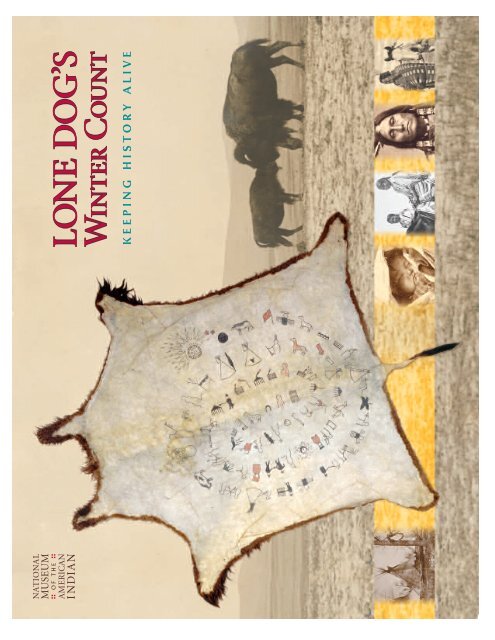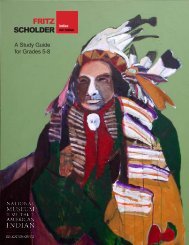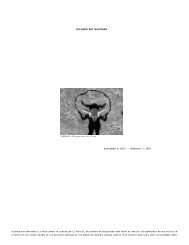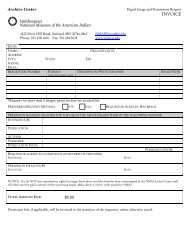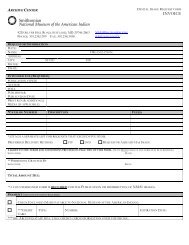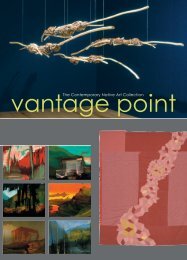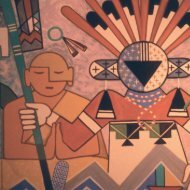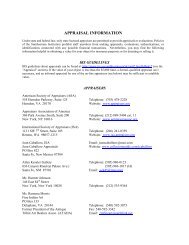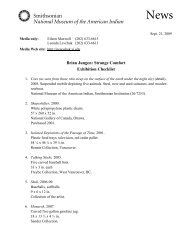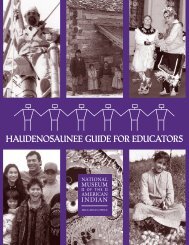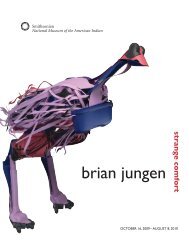Lone Dog's Winter Count - National Museum of the American Indian ...
Lone Dog's Winter Count - National Museum of the American Indian ...
Lone Dog's Winter Count - National Museum of the American Indian ...
You also want an ePaper? Increase the reach of your titles
YUMPU automatically turns print PDFs into web optimized ePapers that Google loves.
KEEPING HIST ORY ALIVE
NATIONAL M USEUM OF THE A MERICAN I NDIAN<br />
LONE DOG’S WINTER COUNT:<br />
K EEPING H ISTORY A LIVE<br />
Grade Level: 4–8<br />
Time Required: Approximately 4 one-hour class periods and 2-3 homework sessions<br />
OVERVIEW<br />
Students learn about <strong>the</strong> oral culture and history-keeping<br />
<strong>of</strong> <strong>the</strong> Nakota people, who made <strong>the</strong> <strong>Lone</strong> Dog <strong>Winter</strong><br />
<strong>Count</strong>. Then <strong>the</strong>y create a monthly pictograph calendar<br />
<strong>of</strong> <strong>the</strong>ir own to document a year <strong>of</strong> <strong>the</strong>ir personal history.<br />
C URRICULUM S TANDARDS FOR<br />
S OCIAL S TUDIES<br />
<strong>National</strong> Council for <strong>the</strong> Social Studies<br />
• Provide for <strong>the</strong> study <strong>of</strong> <strong>the</strong> ways human beings view<br />
<strong>the</strong>mselves in and over time.<br />
• Provide for <strong>the</strong> study <strong>of</strong> culture and cultural diversity.<br />
The Nakota Make Peace<br />
with <strong>the</strong> Crow <strong>Indian</strong>s<br />
<strong>Lone</strong> Dog <strong>Winter</strong> <strong>Count</strong><br />
(detail), 1851-52.<br />
BACKGROUND<br />
O BJECTIVES<br />
In this lesson, students will:<br />
• Learn about <strong>the</strong> practice <strong>of</strong> making winter counts<br />
among some Native <strong>American</strong> groups.<br />
• Study <strong>the</strong> <strong>Lone</strong> Dog <strong>Winter</strong> <strong>Count</strong>.<br />
• Learn about history keeping in an oral culture.<br />
• Understand how storytellers use pictographs as<br />
mnemonic devices.<br />
• Create a pictograph calendar <strong>of</strong> a year in <strong>the</strong>ir<br />
own lives.<br />
Communities are defined by <strong>the</strong>ir languages, cultures, and histories. The languages <strong>of</strong><br />
Native <strong>American</strong>s were not traditionally written. They were only spoken, which meant<br />
that tribal histories and o<strong>the</strong>r important information had to be remembered by people<br />
and passed down orally from generation to generation. This is what is known as an<br />
oral tradition. Sometimes, Native communities used creative tools to help <strong>the</strong>m<br />
remember <strong>the</strong>ir complex histories. A winter count was one such tool that certain<br />
Native <strong>American</strong> communities <strong>of</strong> <strong>the</strong> Nor<strong>the</strong>rn Great Plains region used to help<br />
record <strong>the</strong>ir histories and to keep track <strong>of</strong> <strong>the</strong> passage <strong>of</strong> years. Here is how it worked:<br />
in <strong>the</strong>se communities, <strong>the</strong> annual cycle was measured not from January through<br />
December; but ra<strong>the</strong>r from <strong>the</strong> first snowfall to <strong>the</strong> next year’s first snowfall. This<br />
entire year was sometimes referred to as a winter. Near <strong>the</strong> end <strong>of</strong> each year, elders in<br />
each community met for an important discussion. They talked about <strong>the</strong> things that<br />
had happened since <strong>the</strong> first snowfall and <strong>the</strong>y chose one particular event to serve as a<br />
historical reminder for <strong>the</strong> whole year. The year was <strong>the</strong>n forever named after <strong>the</strong> chosen<br />
event. It <strong>the</strong>n became <strong>the</strong> responsibility <strong>of</strong> one person in <strong>the</strong> community to design<br />
T EACHING P OSTER<br />
1
Background continued<br />
and paint onto a buffalo hide a pictograph, a picture that symbolized<br />
<strong>the</strong> event. The keeper, as this person was known, painted a<br />
new pictograph on <strong>the</strong> hide each year to commemorate that year’s<br />
event. The hide, with all <strong>of</strong> its symbols representing <strong>the</strong> community’s<br />
history, was known as <strong>the</strong> winter count. The important job<br />
<strong>of</strong> keeping <strong>the</strong> winter count was <strong>of</strong>ten passed down from fa<strong>the</strong>r<br />
to son in <strong>the</strong> same family. If <strong>the</strong> images on a winter count faded<br />
or if <strong>the</strong> hide became worn, <strong>the</strong> keeper would make a new copy<br />
to preserve <strong>the</strong> information. Some winter counts were also drawn<br />
on paper or cloth.<br />
The winter count keeper was also a storyteller. These storytellers<br />
were very important to <strong>the</strong> oral tradition because it was <strong>the</strong>ir job<br />
to preserve and pass along <strong>the</strong> community information. By using<br />
<strong>the</strong> winter count, <strong>the</strong> storyteller was able to teach community<br />
members about <strong>the</strong>ir history and to answer questions about<br />
events that had occurred in <strong>the</strong> past. The winter count served as a<br />
mnemonic device. This means that <strong>the</strong> pictographs drawn on it<br />
helped <strong>the</strong> people remember lots <strong>of</strong> things that happened each<br />
year. For example, when we look at a family photograph today, it<br />
can remind us <strong>of</strong> many things about <strong>the</strong> people in <strong>the</strong> picture. By<br />
looking at a pictograph on a winter count, community members<br />
could recall not only <strong>the</strong> event that <strong>the</strong> year was named for, but<br />
o<strong>the</strong>r things too, such as when babies were born, when marriages<br />
took place, or when new leaders were chosen. As a record <strong>of</strong> history,<br />
<strong>the</strong> winter count reminded <strong>the</strong> people <strong>of</strong> who <strong>the</strong>y were and where<br />
<strong>the</strong>y had come from, in <strong>the</strong> same way that our written<br />
histories serve today. This helped keep <strong>the</strong> community<br />
strong and united because it was <strong>the</strong> connection to <strong>the</strong>ir<br />
past. In an oral tradition such as that <strong>of</strong> <strong>the</strong> Nakota,<br />
remembering history was a very important job that was<br />
done with seriousness, respect, and utmost care. This is<br />
why winter counts were so important to <strong>the</strong> <strong>American</strong><br />
<strong>Indian</strong> communities that used <strong>the</strong>m.<br />
T EACHING P OSTER<br />
2<br />
THE LONE DOG<br />
WINTER COUNT<br />
The <strong>Lone</strong> Dog <strong>Winter</strong> <strong>Count</strong> (pictured on <strong>the</strong> front <strong>of</strong> this<br />
poster) came from <strong>the</strong> Yanktonais Nakota community. A<br />
Yanktonais (YANK-tow-nigh) man known as <strong>Lone</strong> Dog was <strong>the</strong><br />
last known keeper <strong>of</strong> this winter count, and that is why it bears<br />
his name. This <strong>Winter</strong> <strong>Count</strong> contains pictographs that document<br />
seventy years <strong>of</strong> Yanktonais history, beginning in <strong>the</strong> winter <strong>of</strong><br />
1800 and ending in 1871. The <strong>Lone</strong> Dog <strong>Winter</strong> <strong>Count</strong> contains<br />
<strong>the</strong> records <strong>of</strong> many important events: <strong>of</strong> encounters with o<strong>the</strong>r<br />
Native peoples and with non-Natives, <strong>of</strong> years when <strong>the</strong>re were<br />
disease epidemics, and <strong>of</strong> times <strong>of</strong> war. The pictographic symbols<br />
begin in <strong>the</strong> center <strong>of</strong> <strong>the</strong> hide and spiral outward in a counterclockwise<br />
direction.<br />
The Yanktonais are part <strong>of</strong> a much larger tribe <strong>of</strong> Native<br />
<strong>American</strong>s known as <strong>the</strong> Sioux. There are three dialects <strong>of</strong> <strong>the</strong><br />
Sioux language—Dakota, Nakota, and Lakota. The Yanktonais<br />
are Nakota speakers. Traditionally, <strong>the</strong> Yanktonais were fur<strong>the</strong>r<br />
divided into tiyospaye (tee-YO-spa-yay), or smaller communities<br />
<strong>of</strong> one or more extended families with grandparents, parents,<br />
children, aunts, uncles, cousins, friends, and allies. The tiyospaye<br />
was an essential part <strong>of</strong> Nakota social, political, and cultural life.<br />
The members <strong>of</strong> a tiyospaye traveled and <strong>of</strong>ten lived toge<strong>the</strong>r in a<br />
small village, crossing <strong>the</strong> Plains in search <strong>of</strong> buffalo and places to<br />
camp. The Nakota territory encompassed much <strong>of</strong> what is now<br />
<strong>the</strong> eastern portions <strong>of</strong> North and South Dakota (see map activity).<br />
Their Lakota cousins, who lived to <strong>the</strong> west and <strong>the</strong> Dakota, who<br />
lived to <strong>the</strong> east, were also<br />
divided into smaller groups<br />
<strong>of</strong> tiyospaye. <strong>Winter</strong> counts<br />
have been found and identified<br />
from Lakota and o<strong>the</strong>r<br />
Nakota tiyospaye.<br />
Kills Two (Lakota) in a posed photo<br />
<strong>of</strong> a winter count keeper.<br />
Photograph by John Anderson. <strong>National</strong><br />
Anthropological Archives, Smithsonian<br />
Institution NAA INV 03494000
THE YEAR THE STARS FELL<br />
This astronomical event recorded on <strong>the</strong> <strong>Lone</strong> Dog <strong>Winter</strong> <strong>Count</strong><br />
was seen by people in many parts <strong>of</strong> <strong>the</strong> world in <strong>the</strong> fall <strong>of</strong> 1833.<br />
It is known widely as <strong>the</strong> Leonid Meteor Storm. It was also<br />
recorded on o<strong>the</strong>r Sioux winter counts. The red ovals represent<br />
falling stars, which surround a black crescent moon.<br />
TRADITIONAL SIOUX LANDS<br />
Discussion and Research Questions:<br />
• What states are <strong>the</strong> traditional homelands <strong>of</strong> <strong>the</strong> Sioux? The Nakota?<br />
(Remember that <strong>American</strong> <strong>Indian</strong>s lived in <strong>the</strong>se areas before <strong>the</strong>y<br />
were states)<br />
• What is <strong>the</strong> environment like in <strong>the</strong>se states?<br />
• What are some <strong>of</strong> <strong>the</strong> native animals<br />
in <strong>the</strong>se states?<br />
• What are <strong>the</strong> names <strong>of</strong> some rivers<br />
and lakes in <strong>the</strong>se states?<br />
Map courtesy <strong>of</strong> <strong>National</strong> <strong>Museum</strong> <strong>of</strong> Natural<br />
History and <strong>National</strong> Anthropological Archives,<br />
Lakota <strong>Winter</strong> <strong>Count</strong>s: An Online Exhibit.<br />
http://www.wintercounts.si.edu Based on<br />
Handbook <strong>of</strong> North <strong>American</strong> <strong>Indian</strong>s,<br />
Smithsonian Institution<br />
T EACHING P OSTER<br />
3<br />
REPRODUCIBLE 1<br />
It is a cold clear night on <strong>the</strong> high nor<strong>the</strong>rn<br />
plains in November 1833. A group <strong>of</strong><br />
Yanktonais Nakota have ga<strong>the</strong>red to gaze at <strong>the</strong><br />
night sky. The starlit skies envelop <strong>the</strong> Earth<br />
from horizon to horizon. There are no o<strong>the</strong>r<br />
sources <strong>of</strong> light to interfere, and millions <strong>of</strong> stars<br />
hang brilliantly suspended above <strong>the</strong> ground,<br />
almost touchable. Some are bigger and brighter<br />
than o<strong>the</strong>rs, some glow with warm reddish<br />
tones, o<strong>the</strong>rs pulse vividly white, and some are<br />
<strong>Lone</strong> Dog <strong>Winter</strong> <strong>Count</strong> (detail)<br />
tinted blue and silver. Tonight something very<br />
special is also happening in this sky. Every few minutes a reddish light streaks across <strong>the</strong> sky and fades<br />
into nothing. To <strong>the</strong> Yanktonais, it seems as if <strong>the</strong> stars are falling. The people will observe this celestial<br />
phenomenon throughout much <strong>of</strong> November, and it will serve as a significant event in <strong>the</strong>ir collective<br />
memory and become a part <strong>of</strong> <strong>the</strong> community’s history.
PREPARATION<br />
Make copies <strong>of</strong> <strong>the</strong> following handouts:<br />
• Reproducibles 1-4<br />
PROCEDURE<br />
1. In small groups, have students study <strong>the</strong> poster image<br />
<strong>of</strong> <strong>the</strong> <strong>Lone</strong> Dog <strong>Winter</strong> <strong>Count</strong>, or use a projector to<br />
show <strong>the</strong>m <strong>the</strong> winter count image from <strong>the</strong> following<br />
website: http://www.americanindian.si.edu/wintercount/<br />
<strong>Lone</strong>DogWC.html<br />
As a class, discuss <strong>the</strong> following questions:<br />
• What kinds <strong>of</strong> images do you see on <strong>the</strong> front <strong>of</strong> this<br />
poster?<br />
• Do you have any guesses about what all <strong>of</strong> <strong>the</strong>se<br />
images have in common? (The <strong>Indian</strong>s <strong>of</strong> <strong>the</strong> Plains<br />
region [<strong>the</strong> Sioux in this case] lived in villages made<br />
up <strong>of</strong> homes called tipis. The buffalo was an important<br />
source <strong>of</strong> food and o<strong>the</strong>r materials. The buffalo<br />
hide in <strong>the</strong> picture was used to make a <strong>Winter</strong> <strong>Count</strong>,<br />
which was a way <strong>of</strong> helping to preserve <strong>the</strong> history <strong>of</strong><br />
a community <strong>of</strong> Sioux people for many generations.)<br />
• How many stages <strong>of</strong> life can you recognize in <strong>the</strong><br />
photographs <strong>of</strong> <strong>the</strong> people? Why is it important to<br />
show all four? (Infant, adolescent, adult, and elder—<br />
we’re learning about preserving community history<br />
for future generations.)<br />
• Look closely at <strong>the</strong> images on <strong>the</strong> buffalo hide (<strong>the</strong><br />
<strong>Winter</strong> <strong>Count</strong>). What do you think <strong>the</strong>y are? What<br />
stories do you think <strong>the</strong>y tell?<br />
2. Use <strong>the</strong> Teacher Background Information to explain<br />
<strong>the</strong> <strong>Lone</strong> Dog <strong>Winter</strong> <strong>Count</strong> to students. For older or<br />
more advanced students, copy <strong>the</strong> Teacher Background<br />
Information and have students read it on <strong>the</strong>ir own.<br />
3. Have students experiment with creating pictographs to<br />
help <strong>the</strong>m remember an important story. Give students<br />
this assignment to complete: ask an older relative<br />
(parent, aunt, uncle, grandparent) or ano<strong>the</strong>r adult to<br />
choose a family or o<strong>the</strong>r story about <strong>the</strong> student to tell,<br />
preferably one <strong>the</strong> student hasn’t heard before. The story<br />
should be fairly detailed; it should take 5-10 minutes to<br />
tell. Before hearing <strong>the</strong> story, students should ga<strong>the</strong>r<br />
pen and paper, but refrain from writing while <strong>the</strong>y are<br />
listening to <strong>the</strong> story. Instead <strong>of</strong> writing, students<br />
should draw 4-7 pictographs that will help <strong>the</strong>m<br />
remember <strong>the</strong> story and retell it accurately and with as<br />
T EACHING P OSTER<br />
4<br />
much detail as possible. After listening to <strong>the</strong> story, <strong>the</strong><br />
student should finalize <strong>the</strong> pictographs, and <strong>the</strong>n retell<br />
<strong>the</strong> story for <strong>the</strong> older relative, who should make sure<br />
that <strong>the</strong> retelling is accurate and that all <strong>the</strong> important<br />
details are included.<br />
4. The next day, have volunteers tell <strong>the</strong>ir family story to<br />
<strong>the</strong> class, showing <strong>the</strong> class <strong>the</strong>ir pictographs. Discuss<br />
with students how easy or difficult it was to remember<br />
<strong>the</strong> story, how <strong>the</strong> pictographs helped, and how <strong>the</strong>y<br />
decided what to draw. Remind students that most families<br />
keep <strong>the</strong>ir important history orally.<br />
5. Have students read <strong>the</strong> text <strong>of</strong> Reproducible 1, The<br />
Year <strong>the</strong> Stars Fell. Make sure that students understand<br />
what a meteor shower is and how it appears. Discuss<br />
how <strong>the</strong> lack <strong>of</strong> ground lights (in cities, etc.) increases<br />
our ability to see <strong>the</strong> night skies. Have students review<br />
<strong>the</strong> map <strong>of</strong> traditional Sioux lands. Complete <strong>the</strong><br />
discussion and research questions. Students will need<br />
access to various types <strong>of</strong> maps <strong>of</strong> <strong>the</strong> region to<br />
complete <strong>the</strong> research questions.<br />
6. To gain familiarity with pictographs, have students<br />
complete <strong>the</strong> matching exercise on Reproducible 2, <strong>the</strong><br />
<strong>Lone</strong> Dog Pictographs handout. Here are <strong>the</strong> correct<br />
answers: 1-L, 2-K, 3-I, 4-B, 5-G, 6-D, 7-F, 8-E, 9-C, 10-A,<br />
11-J, 12-H. After students complete <strong>the</strong> handout,<br />
discuss <strong>the</strong> following question with <strong>the</strong> class:<br />
• How did <strong>the</strong> Native artist draw differences between<br />
types <strong>of</strong> people (Natives <strong>of</strong> different tribes, whites,<br />
men/women)?<br />
7. Explain to students that <strong>the</strong>y will be creating a pictograph<br />
calendar <strong>of</strong> <strong>the</strong>ir own. To make <strong>the</strong> project<br />
interesting for people <strong>of</strong> <strong>the</strong>ir age, <strong>the</strong>y will be counting<br />
months, not winters. Their “count” will be a series <strong>of</strong><br />
pictographs that will enable <strong>the</strong>m to retell <strong>the</strong>ir personal<br />
history, month by month, over <strong>the</strong> last year.<br />
8. Give each student a copy <strong>of</strong> Reproducible 3, <strong>the</strong><br />
Personal Pictograph Calendar—Planning Handout.<br />
Give <strong>the</strong>m about a week to work outside <strong>of</strong> class on<br />
ga<strong>the</strong>ring events for this planning handout. Explain<br />
that <strong>the</strong>y should think <strong>of</strong> occurrences at home, at
Procedure continued<br />
school, with friends, in <strong>the</strong>ir community, or in <strong>the</strong>ir<br />
country. They should list at least two <strong>of</strong> <strong>the</strong>se events<br />
in <strong>the</strong> column “Two Events That Occurred During<br />
This Month.” Then explain that, like <strong>the</strong> Nakota, <strong>the</strong>y<br />
will choose one event (<strong>of</strong> <strong>the</strong> two already listed, or an<br />
additional event) and create a pictograph <strong>of</strong> it. On<br />
<strong>the</strong> Planning Handout, this event is called <strong>the</strong><br />
Calendar Event.<br />
Explain and demonstrate how to complete <strong>the</strong><br />
Planning Handout. On <strong>the</strong> board, list at least two<br />
events that occurred during one month. For example,<br />
in February, you might list “visited grandmo<strong>the</strong>r on<br />
her 93rd birthday” and “shoveled driveway four times<br />
in one day during blizzard.” Choose one <strong>of</strong> <strong>the</strong>se events<br />
as <strong>the</strong> Calendar Event. Then, create a pictograph <strong>of</strong> <strong>the</strong><br />
event. Explain how <strong>the</strong> pictograph is a mnemonic<br />
device that will help jog memories <strong>of</strong> o<strong>the</strong>r things that<br />
have happened. Be sure students understand that <strong>the</strong>ir<br />
Personal Pictograph Calendar documents <strong>the</strong>ir personal<br />
history; <strong>the</strong> <strong>Lone</strong> Dog <strong>Winter</strong> <strong>Count</strong> documents<br />
community history.<br />
9. After students have completed <strong>the</strong> Planning<br />
Handout, give <strong>the</strong>m 1-2 class periods to work on <strong>the</strong>ir<br />
personal pictograph calendar. These calendars can be<br />
created on poster board, sheets <strong>of</strong> brown craft paper, or<br />
fabric. The pictographs can be drawn or painted and<br />
arranged in a spiral (like <strong>Lone</strong> Dog’s) or a line, square,<br />
or ano<strong>the</strong>r shape.<br />
10. Organize a personal history-telling event. If your<br />
class is small enough, each student can use his pictograph<br />
calendar to tell his personal history to <strong>the</strong> entire<br />
class. Or, in groups <strong>of</strong> four or five led by a parent volunteer,<br />
students can tell <strong>the</strong>ir personal histories. Invite<br />
students’ families to attend. Videotape <strong>the</strong> students’<br />
stories as examples <strong>of</strong> how history is <strong>of</strong>ten kept in<br />
today’s world. Make copies for <strong>the</strong> students’ families.<br />
Display <strong>the</strong> personal pictographs in your classroom.<br />
T EACHING P OSTER<br />
5<br />
11. Have students read <strong>the</strong> text <strong>of</strong> Reproducible 4,<br />
Remembering Native <strong>American</strong> History Today. Discuss <strong>the</strong><br />
following questions with students.<br />
• What questions would you have liked to ask <strong>Lone</strong><br />
Dog about this winter count?<br />
• How does retelling it help preserve a community’s<br />
history? How does writing it down preserve history?<br />
EXTENSION<br />
Learn about o<strong>the</strong>r winter counts at <strong>the</strong>se websites:<br />
• Smithsonian <strong>Winter</strong> <strong>Count</strong> Project<br />
http://www.wintercounts.si.edu<br />
• The Buechel Memorial Lakota <strong>Museum</strong><br />
http://www.sfmission.org/museum/exhibits/wintercounts/<br />
buechel_wintercount_objects.shtml describes <strong>the</strong> winter<br />
counts collected by Fr. Eugene Buechel.<br />
• The Carnegie <strong>Museum</strong><br />
http://www.carnegiemuseums.org/cmnh/exhibits/northsouth-east-west/lakota/winter_count/L_WC.html<br />
displays a<br />
contemporary winter count by Thomas Red Owl Haukaas,<br />
M.D. (Sicangu [Brule] Lakota/Creole).<br />
• <strong>National</strong> <strong>Museum</strong> <strong>of</strong> <strong>the</strong> <strong>American</strong> <strong>Indian</strong><br />
http://www.americanindian.si.edu/wintercount/index.html to<br />
learn about <strong>the</strong> 2001 Little Wound School digital workshop<br />
in which <strong>the</strong> Little Wound Tribal School <strong>of</strong> <strong>the</strong> Pine Ridge<br />
Reservation, South Dakota, sent a team <strong>of</strong> students, teachers,<br />
and an elder to <strong>the</strong> NMAI Cultural Resources Center in<br />
Maryland to participate in a workshop on Lakota and<br />
Dakota winter counts and <strong>the</strong>ir connections to <strong>the</strong> students’<br />
Native <strong>American</strong> heritage.
REMEMBERING<br />
NATIVE A MERICAN H ISTORY TODAY<br />
To Native <strong>American</strong> communities today, remembering history is<br />
just as important as it was to previous generations. Native people<br />
have faced many challenges to <strong>the</strong>ir cultures as a result <strong>of</strong> wars,<br />
diseases, forced relocations, and political and religious pressure<br />
to adopt non-<strong>Indian</strong> ways <strong>of</strong> life. While Native <strong>American</strong>s have<br />
endured, survival has come at a great price. Many tribal histories,<br />
languages, songs, dances and o<strong>the</strong>r aspects <strong>of</strong> culture have been<br />
T EACHING P OSTER<br />
6<br />
REPRODUCIBLE 4<br />
seriously eroded or altoge<strong>the</strong>r lost. Communities must maintain<br />
vigilant efforts to keep from losing even more. Today, most<br />
Native <strong>American</strong>s speak English, but many still speak <strong>the</strong><br />
language <strong>of</strong> <strong>the</strong>ir tribe and pass it on to <strong>the</strong>ir children.<br />
Remembering and preserving community histories and cultures<br />
is an important priority for Native <strong>American</strong>s today.<br />
Oral history is very valuable. We try to keep that alive. Today, I still visit with many <strong>of</strong> <strong>the</strong> elders<br />
from different communities, and we talk about one major event that happens during <strong>the</strong> year.<br />
Some students at our college participate in a <strong>Winter</strong> <strong>Count</strong> project where <strong>the</strong>y do <strong>the</strong> history <strong>of</strong> <strong>the</strong>ir<br />
own family. When <strong>the</strong>y do that <strong>the</strong>y understand <strong>the</strong> spiritual importance <strong>of</strong> it. Today, we use modern<br />
technology—video and sound recordings—to help us record our community histories.<br />
DISCUSSION QUESTIONS<br />
—Albert White Hat (Lakota), Lakota language instructor, Sinte Gleska University<br />
Photo courtesy <strong>of</strong> Lakota Studies Department, Sinte Gleska University, photographer unknown<br />
Iam a member <strong>of</strong> a <strong>Winter</strong> <strong>Count</strong> Society which is made<br />
up <strong>of</strong> descendants <strong>of</strong> people who had winter counts, or<br />
who have gotten <strong>the</strong>m back—anything to do with winter<br />
counts. I’m very proud <strong>of</strong> my people and my history. My<br />
mo<strong>the</strong>r used to tell me, “There are billions <strong>of</strong> people in <strong>the</strong><br />
world, and you were lucky enough to be born as a Lakota.”<br />
I’ve always had a good sense <strong>of</strong> my history, and I want to<br />
instill that in my son. My family will know <strong>the</strong>ir history, in<br />
any and every way.<br />
—Tipiziwin Young (Lakota/Nakota/Dakota-<br />
Standing Rock Sioux)<br />
Photo by John Lenker, courtesy <strong>of</strong><br />
<strong>National</strong> <strong>Museum</strong> <strong>of</strong> Natural History<br />
My great-great-grandfa<strong>the</strong>r . . . translated <strong>the</strong> <strong>Lone</strong> Dog <strong>Winter</strong> <strong>Count</strong> in<br />
<strong>the</strong> 1860s. Our challenge is to remember as a tribal people . . . we have a<br />
responsibility to continue that way <strong>of</strong> keeping track <strong>of</strong> what happens in a year . . .<br />
At <strong>the</strong> same time, as we live our lives each day, we have to take what we learn<br />
from those winter counts and take what we learn from our elders and pass it on<br />
to <strong>the</strong> children. A people without history is like wind blowing in <strong>the</strong> prairie grass.<br />
—Steve Emery (Lakota-Cheyenne River Sioux),<br />
Administrative Attorney, Rosebud Sioux Tribe<br />
Photo by John Lenker, courtesy <strong>of</strong> <strong>National</strong> <strong>Museum</strong> <strong>of</strong> Natural History<br />
• Why is it important for Native <strong>American</strong>s today to preserve <strong>the</strong>ir histories?<br />
• What role do modern technologies play in recording Native <strong>American</strong> histories today?
LONE DOG<br />
PICTOGRAPHS HANDOUT<br />
Match <strong>the</strong> letter next to each pictograph, at right, with<br />
<strong>the</strong> explanation, below.<br />
____ 1. The Nez Perces came to <strong>Lone</strong>-Horn’s lodge at<br />
midnight. 1852–53<br />
____ 2. White soldiers made <strong>the</strong>ir first appearance in<br />
<strong>the</strong> region. 1823–24<br />
____ 3. Plenty <strong>of</strong> buffalo meat. 1845–46<br />
____ 4. Eight Nakotas were killed. 1863–64<br />
____ 5. La Framboise, a Canadian, built a trading<br />
store with dry timber. 1817–18<br />
____ 6. The Nakotas killed a Crow woman. 1857–58<br />
____ 7. The Nakotas made peace with <strong>the</strong> Cheyennes.<br />
1840–41<br />
____ 8. Buffalo belly was plenty (food, clothing and<br />
o<strong>the</strong>r materials). 1816–17<br />
____ 9. Buffalo were so plentiful that <strong>the</strong>ir tracks<br />
came close to <strong>the</strong> tipis. 1861–62<br />
____ 10. Four-Horn was made a calumet or medicine<br />
man. 1856–57<br />
____ 11. There was a remarkable flood in <strong>the</strong><br />
Missouri River and a number <strong>of</strong> <strong>Indian</strong>s<br />
were drowned. 1825–26<br />
____ 12. The whooping cough was very prevalent and<br />
fatal. 1813–14<br />
T EACHING P OSTER<br />
7<br />
A B<br />
C D<br />
E F<br />
G H<br />
I J<br />
K L<br />
REPRODUCIBLE 2
PERSONAL PICTOGRAPH CALENDAR<br />
PLANNING HANDOUT<br />
T EACHING P OSTER<br />
8<br />
REPRODUCIBLE 3<br />
Month/Year Two Events that Occurred Calendar Event Pictograph<br />
During this Month<br />
January 1.<br />
2.<br />
February 1.<br />
2.<br />
March 1.<br />
2.<br />
April 1.<br />
2.<br />
May 1.<br />
2.<br />
June 1.<br />
2.<br />
July 1.<br />
2.<br />
August 1.<br />
2.<br />
September 1.<br />
2.<br />
October 1.<br />
2.<br />
November 1.<br />
2.<br />
December 1.<br />
2.
GLOSSARY FOR<br />
TEACHERS<br />
Oral tradition—in a society without a<br />
written language, <strong>the</strong> way in which all<br />
history and culture is remembered by<br />
individuals and passed down orally from<br />
generation to generation.<br />
<strong>Winter</strong> <strong>Count</strong>—a series <strong>of</strong> pictographs<br />
drawn on buffalo hide, cloth, or paper<br />
that was used to help remember<br />
community history among some tribes<br />
<strong>of</strong> <strong>the</strong> Nor<strong>the</strong>rn Great Plains.<br />
Pictograph—a figure drawn on a winter<br />
count to serve as a symbol <strong>of</strong> one significant<br />
event chosen by <strong>the</strong> community to<br />
commemorate each year.<br />
Keeper—<strong>the</strong> person with <strong>the</strong> responsibility<br />
<strong>of</strong> maintaining a winter count and<br />
remembering and passing on <strong>the</strong> history<br />
associated with it.<br />
Mnemonic device—an object, such as a<br />
winter count, that serves as a memory aid<br />
and a tool to help keep track <strong>of</strong> history.<br />
Nakota—one <strong>of</strong> three dialects (slightly<br />
different versions) <strong>of</strong> <strong>the</strong> Sioux language.<br />
Also used as a term to identify <strong>the</strong> groups<br />
<strong>of</strong> <strong>American</strong> <strong>Indian</strong>s who speak <strong>the</strong> dialect.<br />
Dakota—one <strong>of</strong> three dialects (slightly<br />
different versions) <strong>of</strong> <strong>the</strong> Sioux language.<br />
Lakota—one <strong>of</strong> three dialects (slightly<br />
different versions) <strong>of</strong> <strong>the</strong> Sioux language<br />
Yanktonais—one <strong>of</strong> three sub-groups <strong>of</strong><br />
Nakota speakers. <strong>Lone</strong> Dog, <strong>the</strong> last<br />
known keeper <strong>of</strong> <strong>the</strong> <strong>Lone</strong> Dog <strong>Winter</strong><br />
<strong>Count</strong>, was a Yanktonais.<br />
Tiyospaye—among Sioux tribes, an<br />
extended family group that lived and<br />
traveled toge<strong>the</strong>r; usually numbering<br />
about 150-300 people.<br />
TEACHER<br />
RESOURCES<br />
Books and Articles for Adults<br />
Burke, Christina E. “Collecting Lakota<br />
Histories: <strong>Winter</strong> <strong>Count</strong> Pictographs and<br />
Texts in <strong>the</strong> <strong>National</strong> Anthropological<br />
Archives.” <strong>American</strong> <strong>Indian</strong> Art 26:1<br />
(2000): 82-89, 102-03.<br />
DeMallie, Raymond J., ed. Handbook<br />
<strong>of</strong> North <strong>American</strong> <strong>Indian</strong>s, Vol. 13<br />
Plains. Washington, DC: Smithsonian<br />
Institution, 2001.<br />
(See esp. articles on <strong>the</strong> Sioux and on<br />
Tribal Traditions and Records)<br />
Greene, Candace S. and Russell Thornton,<br />
eds. The Year <strong>the</strong> Stars Fell: Lakota <strong>Winter</strong><br />
<strong>Count</strong>s at <strong>the</strong> Smithsonian. Lincoln,<br />
Nebraska: University <strong>of</strong> Nebraska Press,<br />
forthcoming.<br />
Books for Children<br />
Bruchac, Joseph. A Boy Called Slow:<br />
The True Story <strong>of</strong> Sitting Bull. New York:<br />
Putnam, 1998. (primary)<br />
Penman, Sarah, ed. Honor <strong>the</strong><br />
Grandmo<strong>the</strong>rs: Dakota and Lakota<br />
Women Tell Their Stories. St. Paul:<br />
Minnesota Historical Society Press,<br />
2000. (middle school)<br />
Sandoz, Mari. The Story Catcher. Lincoln,<br />
Nebraska: University <strong>of</strong> Nebraska Press,<br />
1986. (secondary)<br />
Standing Bear, Lu<strong>the</strong>r. My People, <strong>the</strong><br />
Sioux. Lincoln, Nebraska: University <strong>of</strong><br />
Nebraska Press, 1975. (secondary)<br />
Todd, Anne M. The Sioux: People <strong>of</strong> <strong>the</strong><br />
Great Plains. Mankato, Michigan:<br />
Bridgestone Books, 2003. (middle school)<br />
Wood, Ted and Wanbli Numpa Afraid <strong>of</strong><br />
Hawk. A Boy Becomes a Man at Wounded<br />
Knee. New York: Walker, 1992. (primary)<br />
T EACHING P OSTER<br />
9<br />
ACKNOWLEDGEMENTS<br />
Project Manager:<br />
Genevieve Simermeyer, NMAI<br />
Writers: Edwin Schupman, NMAI<br />
and Leslie O’Flahavan<br />
Editors: Sally Barrows, NMAI and<br />
Leslie Logan, NMAI<br />
Research Assistance: Candace Greene,<br />
NMNH; Martin Earring, NMAI;<br />
Gayle Yiotis, NMAI<br />
Design and Production:<br />
Gr<strong>of</strong>f Creative, Inc.<br />
Advisors: Albert White Hat, Tipiziwin<br />
Young, Steve Emery<br />
F RONT P HOTO C REDITS<br />
<strong>National</strong> <strong>Museum</strong> <strong>of</strong> <strong>the</strong> <strong>American</strong> <strong>Indian</strong><br />
<strong>Winter</strong> <strong>Count</strong> or Calendar, ca. 1870 by Shunka Ishnala<br />
(<strong>Lone</strong> Dog, Sioux, lifedates unknown), 60X84 in. Photo by<br />
Janine Jones.<br />
Albumen print panoramic view <strong>of</strong> buffalo on <strong>the</strong> plains,<br />
ca. 1900 Photographer unknown.<br />
Bottom strip, left to right:<br />
View <strong>of</strong> Oglala Sioux Camp, 1878. Near Fort Keogh,<br />
Montana(?). Photographer unknown.<br />
Spotted Tail (Brule Sioux), a child <strong>of</strong> Sinte Gleska, Albumen<br />
print studio portrait, ca. 1880. Photographer unknown.<br />
Two young Sioux women on horseback, 4 July 1912. Sioux<br />
Powwow, Rosebud Reservation, South Dakota. Photo by<br />
Roy E. Phelps.<br />
Chon-nom-pa-kin-yan (Flying Pipe, Yankton Sioux),<br />
Albumen print studio portrait, ca. 1890. Photo by William<br />
Henry Jackson.<br />
Crow Dog (Oglala Sioux), Black and white postcard, ca. 1900.<br />
Photographer unknown.


